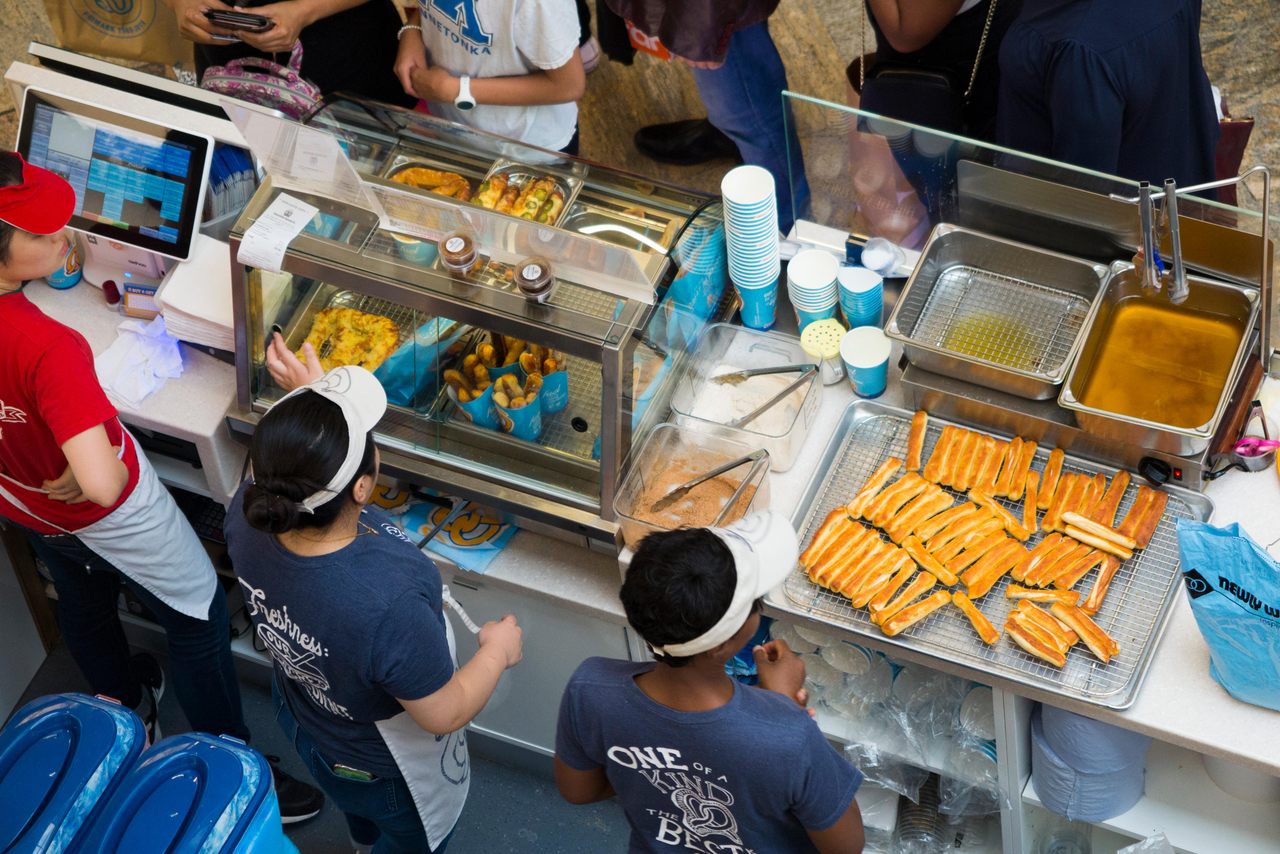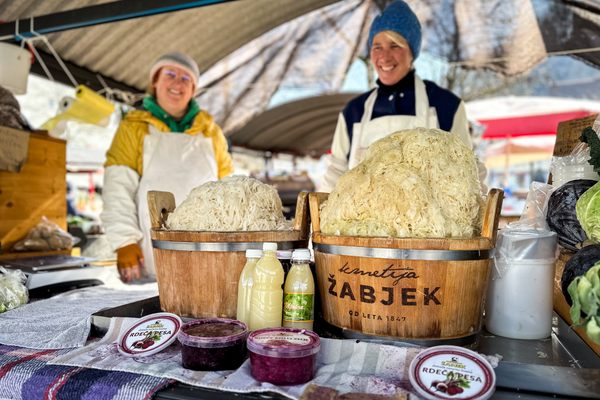How Chain Restaurants Use Smells to Entice Us
When it comes to marketing food, scent can be as important as flavor.
If you’re familiar with the pretzel chain Auntie Anne’s, chances are that you know what its stores smell like. The distinctive, powerful fragrance of freshly-baked, buttery pretzels wafts across food courts in shopping centers, airports, and train stations around the world. Each sniff takes us back to the last time we found ourselves inhaling the delectable aroma. Even if you don’t eat Auntie Anne’s pretzels, their scent is hard to miss wherever the company’s 1,200 locations can be found. And Auntie Anne’s knows it.
“There are few scents more recognizable than the aroma of Auntie Anne’s,” the company’s chief brand officer declared in a press release announcing this signature scent would be bottled and sold as a perfume called “Knead.” Described as “a wearable scent infused with notes of buttery dough, salt and a hint of sweetness,” the fragrance sold out online within 10 minutes of its launch.
The pretzel fragrance is just one of many novelty perfumes and scented candles released by food chains like KFC and Pizza Hut. It’s become a common-enough marketing gimmick that a 2024 Japanese McDonald’s ad that fancifully depicted french-fry flavors as perfume bottles sparked a rumor that the company would actually sell them. (They did not, although McDonald’s did recently unveil the world’s first scented billboard in the Netherlands.)


“Scent branding is now becoming such a huge topic,” says Tianyi Zhang, a PhD candidate in experimental psychology at the University of Oxford, whose research focuses on how sensory experiences impact consumer behavior. “The idea is that [businesses] create very strong associations, so once you smell it, you think of it.” The strategic use of scent by businesses to influence consumers, also known as “scent marketing,” is not limited to restaurants. It’s been an element of marketing since the 1970s, when advances in technology allowed for the scent of products to be modified and customized. But while a retailer might pipe in artificial perfume—like electronics giant Samsung, which uses a hint of honeydew melon in its flagship commercial space in New York—some restaurants and bakeries use the scent of their product to drive consumer traffic and recognition.
Because chain restaurants use standardized ingredients and equipment, the smell of their food can be as consistent and recognizable as a visual logo. It can also be featured as prominently as one. “Aroma is who we are—it is our greatest asset,” one Cinnabon franchise owner told the Wall Street Journal in 2014. Cinnabon deliberately places its ovens near the front of its stores to disperse the scent of cinnamon rolls, and some locations even warm extra cinnamon-sugar on baking sheets to keep the smell persistent. And Panera Bread has experimented with switching its bread-baking from nighttime to daytime, when customers are present.
Another scent experience that rivals Auntie Anne’s in its distinctiveness is that of Subway, the sandwich chain. Open the door of any franchise and you’ll be hit with the particular scent of Subway’s bread, thanks to a proprietary dough recipe, which in the United States is prepared at just 11 facilities before being frozen and shipped for baking on-site nationwide. The company has denied positioning its ovens to increase scent distribution and remains secretive about the actual composition of its bread, but it’s likely that the unique smell derives at least in part from a uniquely high sugar content (so much that in 2020, the Supreme Court of Ireland ruled that Subway’s rolls were too sugary to meet the legal definition of “bread”).

However, Zhang points out that while chains like Cinnabon can simply “maximize the smell” of their product to appeal to passersby, “different smells can lead to very different outcomes” in terms of marketing. Not every food scent brings equally positive associations, and aromas at the same location can interfere with one another. This was the case in 2008, when Starbucks reported that the smell of their grilled breakfast sandwiches was masking the smell of their coffee and negatively impacting coffee sales. “After six months of adjustments, including the use of leaner bacon, higher-quality ingredients, and a lower cooking temperature, the paninis were reintroduced to their stores, but now with a less intrusive odour,” Zhang wrote in a review of experimental research on consumer behavior and scent.
Zhang says that if a restaurant wants to make use of scent in its branding and marketing, “it is very important for the restaurant itself to know what they actually want out of it.” Trade show and event marketing magazine Exhibitor, for example, suggests “thematic smells” tailored to enhance the messaging of product displays. “If you were selling a product that protected [customers], e.g. safes or firearms, you might choose smells often associated with alertness, such as citrus or peppermint,” wrote Charles Pappas, a senior writer at the magazine, while “scents associated with calmness, such as vanilla or lavender,” might invite customers to relax.
In the case of restaurant marketing, we might assume that the smell of a food will directly increase people’s desire to eat it. But “smell doesn’t work that consistently” on appetite, says Zhang. “It really depends on whether the people that come to your restaurant are hungry or not” and the type of food they usually prefer, among many other variables. Zhang notes that one food smell does appear to influence appetite more consistently than others: fruit. “If people smell pear,” says Zhang, “they would prefer a pear dessert compared to other desserts.”

Zhang suggests that this might be because “people tend to rank smells higher [and] enjoy them more if they can identify them immediately.” Fruit smells are more recognizable than prepared food smells, which are made up of multiple ingredients and may be hard to place. In retail settings, simple, easy-to-identify scents have been linked to increased consumer spending over complex ones, as scents that require minimal brain processing create a feeling of calm, encouraging shoppers to linger. Fruit may also prompt more distinct mental associations for consumers compared with some other foods, especially those considered unhealthy. Zhang describes one study in which McDonald’s found that a melon fragrance increased consumer spending more than the scent of their food on its own (though the chain has yet to adopt artificial melon scent as a strategy). There is still much research to be done, as studies on the effects of scent tend to be limited to those that are most readily available in the form of a flavor essence.
More well-established than the link between scent and appetite is that between scent and memory. Zhang explains that a restaurant’s or other business’s signature smell “will just create that kind of bonding in your head…so that when you think of that brand, you think of that smell, or when you think of the smell, it elicits very positive emotions.” Auntie Anne’s seems well-aware of the way smell can transport us to a specific time, place, or feeling, describing their pretzel-y “Knead” fragrance as “nostalgic.” The customers who caused “Knead” to sell out so quickly agree: In a review of “Knead” posted on Reddit, one customer stated that the perfume “captures the essence of the entire storefront,” adding, “it’s worth it for the journey back to the mall food court or oasis at a crowded airport.” “Now I need one that smells like a Subway,” a commenter wrote in another thread about “Knead.”
Whether fanned across a mall or bottled as perfume, the fragrance of buttery pretzels may not directly cause everyone who smells it to buy more pretzels. But for chain restaurants that use scent as a key element of their branding, the purpose of developing a signature fragrance is not necessarily to increase product sales by exposure. The signature scent of a restaurant spreads through the air to make sure you know that the restaurant is there, waiting for you; it welcomes you, and perhaps reminds you of pleasant times spent there in the past. Scent itself can be a powerful brand ambassador.
Gastro Obscura covers the world’s most wondrous food and drink.
Sign up for our regular newsletter.




































Follow us on Twitter to get the latest on the world's hidden wonders.
Like us on Facebook to get the latest on the world's hidden wonders.
Follow us on Twitter Like us on Facebook